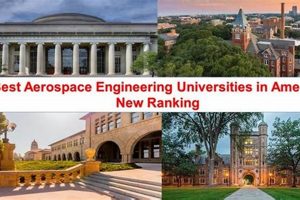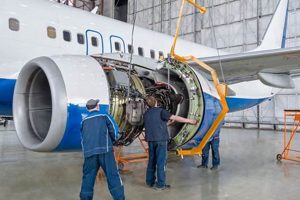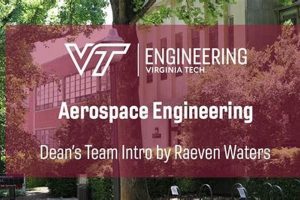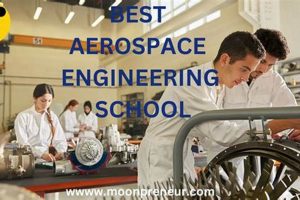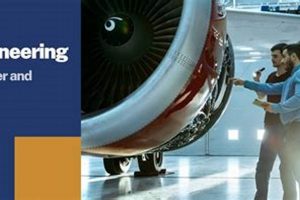Practical work experiences within the aeronautics and astronautics fields, often pursued by individuals enrolled in related undergraduate or graduate programs, offer immersive learning opportunities. These structured programs allow students to apply theoretical knowledge to real-world engineering challenges, often within established aerospace organizations or research institutions. For example, a student might participate in designing aircraft components, analyzing flight data, or contributing to propulsion system development.
These experiences are vital for supplementing academic instruction with hands-on application. They provide a crucial bridge between classroom concepts and the practical demands of the aerospace industry. Furthermore, participation can provide valuable networking opportunities, enhance career prospects post-graduation, and potentially lead to future employment offers. Historically, such programs have played a key role in shaping the careers of many leading engineers and researchers within the field. They allow early career professionals to assess potential specializations and solidify their professional interests within the broader aerospace domain.
The subsequent sections will explore diverse opportunities available, strategies for securing coveted placements, required qualifications and essential skills, and the lasting impact on career trajectory following these immersive practical experiences.
Guidance for Securing Practical Training Opportunities
The following recommendations aim to enhance the probability of securing a sought-after practical training placement within the aerospace sector. The guidance provided prioritizes preparation, strategic planning, and a comprehensive understanding of industry expectations.
Tip 1: Cultivate a Strong Academic Foundation: Prioritize excellence in core aerospace engineering coursework. Employers often seek candidates with a demonstrated aptitude in subjects such as aerodynamics, propulsion, structural analysis, and control systems. A high GPA signals commitment and competence.
Tip 2: Develop Relevant Technical Skills: Acquire proficiency in industry-standard software and tools. Familiarity with CAD software (e.g., SolidWorks, CATIA), programming languages (e.g., MATLAB, Python), and simulation packages (e.g., ANSYS, NASTRAN) significantly enhances competitiveness. Document these skills on resumes and during interviews.
Tip 3: Build a Compelling Portfolio: Showcase personal projects and extracurricular activities that demonstrate practical application of engineering principles. Examples include participation in collegiate design competitions (e.g., AIAA Design/Build/Fly), research projects with faculty, or involvement in relevant student organizations. Highlight the technical challenges addressed and the outcomes achieved.
Tip 4: Tailor Applications to Specific Opportunities: Customize resumes and cover letters to align with the requirements of each application. Research the organization’s projects and culture, and clearly articulate how skills and experiences match their needs. Generic applications often fail to capture attention.
Tip 5: Network Strategically: Attend industry conferences, career fairs, and university events to connect with aerospace professionals. Cultivate relationships with faculty members and alumni who can provide guidance and referrals. Networking can provide valuable insights into unadvertised opportunities.
Tip 6: Prepare Thoroughly for Interviews: Practice answering common interview questions, including behavioral questions that assess problem-solving abilities and teamwork skills. Be prepared to discuss technical projects in detail and articulate the rationale behind engineering decisions. Conduct mock interviews with career services or mentors.
Tip 7: Demonstrate Enthusiasm and Initiative: Convey genuine passion for aerospace engineering and a proactive approach to learning. Articulate a clear understanding of industry trends and emerging technologies. Highlight instances where initiative was taken to expand knowledge and skills beyond the curriculum.
These recommendations emphasize the importance of a holistic approach to professional development, combining academic achievement with practical skills, strategic networking, and effective communication. Success in securing a practical training placement significantly enhances career prospects and provides invaluable experience.
The subsequent sections will delve into resources for identifying opportunities, navigating the application process, and maximizing the benefits of practical training experiences.
1. Hands-on Experience
Practical training significantly enhances theoretical knowledge within aerospace engineering programs. These experiences provide opportunities to apply learned principles to real-world challenges.
- Design and Analysis Application
Practical training allows students to directly engage in the design and analysis phases of aerospace projects. For example, an individual might utilize CAD software to create a component for an aircraft wing or employ finite element analysis to evaluate structural integrity. These activities provide immediate feedback and reinforce the theoretical concepts learned in the classroom.
- Manufacturing and Testing Exposure
Experiences often involve exposure to manufacturing processes and testing methodologies. A student might participate in the fabrication of composite materials or conduct wind tunnel tests to validate aerodynamic performance. Direct interaction with these processes deepens the understanding of engineering limitations and practical considerations.
- Problem-Solving in Real-World Scenarios
Practical training environments present unpredictable challenges that require creative problem-solving. An individual might encounter unexpected design flaws or performance discrepancies that demand innovative solutions. Navigating these situations fosters adaptability and critical thinking skills essential for successful engineering careers.
- Teamwork and Collaboration
Aerospace projects typically involve collaborative efforts across diverse teams. Participants contribute to group projects, communicate technical information, and coordinate tasks to achieve common goals. These experiences develop crucial interpersonal skills necessary for effective teamwork within the aerospace industry.
The integration of practical, hands-on opportunities within these programs remains crucial for fostering a new generation of capable and innovative aerospace engineers. The skills and insights gained directly contribute to improved performance and a deeper comprehension of the field.
2. Industry Connections
Practical training programs within the aerospace sector serve as a conduit for establishing vital industry connections. These connections often arise organically through direct interaction with professionals, mentors, and potential employers within host organizations. The immersive nature of practical training fosters an environment conducive to networking, enabling students to cultivate relationships that extend beyond the duration of the program. For example, a student involved in an design placement at a leading aerospace manufacturer might collaborate directly with experienced engineers on a critical project. This direct collaboration provides invaluable opportunities to learn industry best practices, receive personalized mentorship, and demonstrate capabilities to prospective employers. Without such interactions, students are isolated and lack professional help in their field.
The significance of these relationships extends beyond immediate opportunities. Established connections can provide access to inside knowledge of the industry, including emerging trends, evolving technologies, and future career paths. Mentors can offer guidance on navigating the complexities of the aerospace landscape, providing insights into career progression strategies, further education options, and potential specialization areas. Furthermore, these connections can serve as valuable references for future employment opportunities, significantly enhancing career prospects post-graduation. The connections students make during placements make their chances of employment higher.
In conclusion, practical training programs are not solely about acquiring technical skills. They represent a crucial platform for fostering industry relationships that can shape career trajectories. These connections provide access to mentorship, insider knowledge, and future opportunities, rendering them an indispensable component of an aerospace engineering student’s overall education and professional development. The advantages are undeniable and make the students better prepared for their professional life.
3. Skill Development
Practical work experiences in aerospace engineering serve as a catalyst for accelerated skill development. These placements provide an environment where theoretical knowledge translates into practical competence. For instance, a student might apply computational fluid dynamics (CFD) principles learned in coursework to simulate airflow around an aircraft wing. This hands-on application reinforces understanding and cultivates proficiency in CFD software. Furthermore, these settings frequently demand the acquisition of new skills not typically covered in academic curricula, such as project management techniques, regulatory compliance procedures, and industry-specific software applications.
The range of skills cultivated during practical training extends beyond technical expertise. Opportunities often require effective communication and collaboration within multidisciplinary teams. Students learn to articulate technical concepts clearly, contribute to group problem-solving, and navigate differing perspectives. Leadership skills can also emerge through project assignments that demand initiative and responsibility. Consider the instance of a student tasked with leading a team in designing a satellite subsystem. The individual gains experience in delegating tasks, coordinating efforts, and ensuring project milestones are met. Such activities greatly improve professional skill for the field
In summary, practical training programs are indispensable for skill development in aerospace engineering. They furnish avenues for applying theoretical knowledge, acquiring new technical competencies, and cultivating essential soft skills. The combined effect of these elements results in a more well-rounded and competitive graduate, prepared to contribute effectively to the aerospace industry. The skills learned are extremely crucial in this competitive world.
4. Career Advancement
The correlation between practical training programs and subsequent career advancement within the aerospace engineering sector is substantial. Participation in these experiences serves as a demonstrable indicator of applied knowledge and industry preparedness, factors highly valued by potential employers. A successful practical work term often translates directly into increased opportunities for full-time employment post-graduation, either with the host organization or within the broader aerospace community. For example, a student who excels during a practical training placement at a company like SpaceX may receive a full-time job offer upon completing their academic program. These offers reflect the company’s confidence in the student’s abilities and potential contributions.
Moreover, practical training programs often provide opportunities for early specialization and skill refinement. Exposure to specific areas within aerospace engineering, such as propulsion systems, avionics, or structural design, enables participants to identify their areas of interest and develop focused expertise. This focused expertise enhances their marketability and opens doors to more specialized roles. For instance, a student who completes a practical training assignment focused on composite materials may be better positioned to secure a role in a materials engineering department within an aerospace manufacturer. Furthermore, successful completion of these program displays pro-activeness.
In conclusion, practical training programs are integral to career advancement for aerospace engineering students. These opportunities not only provide valuable hands-on experience but also foster industry connections, facilitate skill refinement, and enhance employment prospects. The skills learned during placements also help get the first full-time job and give a foundation for one’s career.
5. Technical Application
The core value of practical training in aerospace engineering stems directly from the opportunities for technical application. These experiences provide a structured environment for students to translate theoretical knowledge into tangible outcomes. The ability to apply engineering principles, learned through coursework, to real-world problems represents a crucial step in professional development. Consider, for instance, a student tasked with analyzing the structural integrity of an aircraft component using finite element analysis software during a practical training period at an aerospace company. This exercise compels the student to not only understand the underlying theory of stress and strain but also to competently utilize specialized software tools and interpret the results in a practical context.
The significance of technical application extends beyond the immediate task at hand. It also encompasses the development of critical problem-solving skills, the ability to adapt to unforeseen challenges, and the cultivation of a hands-on approach to engineering design. For example, a student involved in testing a prototype propulsion system may encounter unexpected performance issues. Addressing these issues requires a combination of theoretical understanding, practical troubleshooting skills, and the ability to collaborate effectively with a team of engineers. This process of applying knowledge and adapting to real-world constraints is invaluable in preparing students for the demands of the aerospace industry. They learn to solve practical problems using their educational know-how.
In conclusion, the ability to apply technical knowledge is the cornerstone of practical training in aerospace engineering. These opportunities bridge the gap between academic theory and industrial practice, equipping students with the practical skills, problem-solving abilities, and hands-on experience necessary for success in the field. It is not only a component of a students learning but the primary goal and method of such learning. The challenges encountered and overcome during these learning phases serve as a proving ground, solidifying their understanding of engineering principles and preparing them for the complex demands of the aerospace profession.
Frequently Asked Questions about Practical Training in Aerospace Engineering
The following section addresses common inquiries concerning practical training programs for aerospace engineering students, providing clarity on program requirements, benefits, and application processes.
Question 1: What are the primary benefits derived from participation in practical training opportunities?
Participation offers exposure to real-world engineering challenges, facilitates skill development beyond academic coursework, fosters industry connections, and enhances employment prospects post-graduation.
Question 2: What qualifications are typically sought by employers offering practical training programs?
Employers generally seek candidates with a strong academic record in core aerospace engineering subjects, proficiency in relevant software and tools, and demonstrated problem-solving abilities.
Question 3: How can students effectively identify suitable practical training opportunities?
Resources include university career services, online job boards specializing in engineering positions, industry conferences, and professional networking events.
Question 4: What is the optimal timing for pursuing practical training experiences during an academic program?
Timing varies based on program structure and individual career goals; however, many students pursue opportunities after completing foundational coursework in their sophomore or junior year.
Question 5: Are practical training programs typically paid or unpaid?
Compensation practices vary; however, paid practical training opportunities are increasingly common, particularly within larger aerospace organizations. Compensation levels depend on factors such as experience, location, and the nature of the work performed.
Question 6: What steps can students take to maximize the benefits derived from practical training experiences?
Active engagement in projects, proactive communication with mentors and colleagues, a willingness to learn new skills, and a commitment to contributing meaningfully to the organization are essential for maximizing the value of the experience.
In summary, practical training programs represent a vital component of aerospace engineering education, providing a crucial bridge between academic theory and practical application. Careful planning and active engagement are essential for realizing the full potential of these experiences.
The subsequent section will provide a comprehensive overview of resources available to support students in securing and succeeding in practical training placements.
Conclusion
This exploration has underscored the multifaceted value of internships for aerospace engineering students. The evidence presented demonstrates their critical role in bridging the gap between theoretical knowledge and practical application, fostering essential skill development, cultivating industry connections, and ultimately, advancing career prospects. These immersive experiences provide invaluable opportunities to apply engineering principles to real-world challenges, thereby solidifying understanding and enhancing professional competence. The benefits extend beyond individual skill enhancement, contributing to the overall quality and preparedness of the future aerospace engineering workforce.
In light of the demonstrated benefits, it is incumbent upon students, academic institutions, and industry partners to prioritize and actively facilitate access to high-quality internships for aerospace engineering students. A sustained commitment to providing these opportunities will ensure a robust pipeline of talented and well-prepared engineers, capable of addressing the complex challenges and driving innovation within the aerospace sector. The future of aerospace engineering rests, in part, on the quality and accessibility of these foundational practical training experiences.


